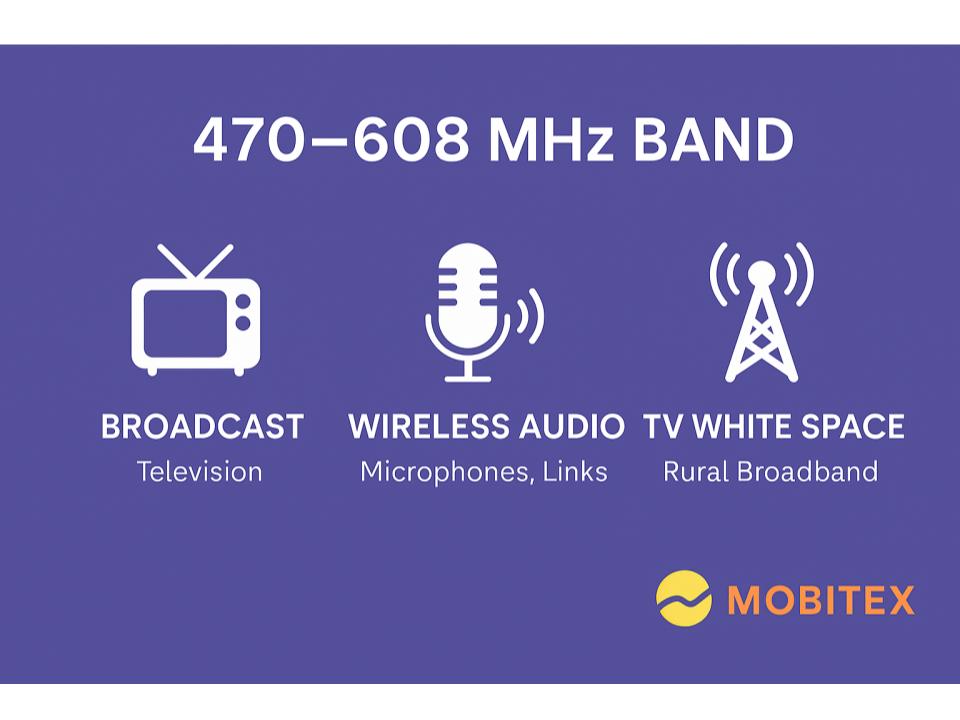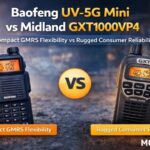📻 The 470–608 MHz band is one of the most important and historically rich sections of the UHF (Ultra High Frequency) spectrum. For decades, it has served as the backbone for television broadcasting, wireless production tools, and more recently, emerging broadband and spectrum-sharing technologies.
🌍 Frequency Overview
- Range: 470 MHz – 608 MHz
- Wavelength: 64 cm – 49 cm
- Classification: UHF Band IV
- Propagation: Excellent coverage and building penetration, ideal for urban and rural broadcasting
This band offers a balanced trade-off between range and bandwidth, making it extremely versatile for both broadcast and wireless communication systems.
📺 Primary Use – Television Broadcasting
Traditionally, this frequency range has been home to UHF television channels 14 to 36.
- It has been used for digital terrestrial television (DTT), including formats like ATSC, DVB-T/T2, and ISDB-T.
- The propagation characteristics allow for wide-area coverage using moderate transmitter power.
Even after spectrum auctions and refarming, broadcast television remains the primary occupant of this band in many countries, especially in Europe, Asia, and Africa.
⚙️ Transition and Reallocation
Over the past two decades, regulators have been repurposing UHF spectrum to make room for mobile broadband services.
- In North America, frequencies above 608 MHz have been reassigned for LTE and 5G (the “600 MHz band”).
- The 470–608 MHz segment remains protected for television broadcasting and wireless production equipment.
This balance aims to preserve over-the-air broadcasting while enabling future shared spectrum models and white-space technologies.
🎤 Secondary Uses
🎧 Wireless Microphones and Audio Links
This band supports professional wireless microphones, in-ear monitors, and intercom systems used in live events, broadcasting, and theater. These devices must operate in a non-interfering, secondary capacity relative to television transmissions.
🌐 TV White Space (TVWS) Broadband
“White spaces” – unused gaps between TV channels – are being leveraged for long-range rural broadband.
- Technologies like IEEE 802.22 (WRAN) and 802.11af (Super Wi-Fi) use cognitive radios to detect free spectrum dynamically.
- TVWS is particularly valuable for connecting remote communities where fiber or cable isn’t viable.
🚨 Public Protection and Disaster Relief (PPDR)
Some regions reserve small segments within this band for public safety and emergency communications, though this is more common in the upper UHF range.
🌎 Regional Allocations
| Region | Primary Services | Secondary / New Uses |
|---|---|---|
| North America | Digital TV (ATSC 1.0/3.0) | TV White Space broadband, wireless microphones |
| Europe | DVB-T/T2 broadcasting | PMSE (Programme Making & Special Events) equipment |
| Asia | TV broadcasting and community stations | Experimental broadband and IoT |
| Africa / Latin America | Analog → digital transition in progress | Hybrid TV and rural broadband initiatives |
🧭 Technical Overview
| Parameter | Detail |
|---|---|
| Frequency range | 470 – 608 MHz |
| ITU Region | Globally recognized UHF Band IV |
| Main allocation | Television Broadcasting |
| Secondary uses | Wireless audio, TV White Space, IoT tests |
| Bandwidth per TV channel | 6 MHz (North America), 7–8 MHz (Elsewhere) |
| Propagation range | Up to 100 km (depending on terrain and power) |
💡 Advantages
✅ Excellent coverage – requires fewer transmitters
✅ Strong indoor penetration
✅ Well-established standards (DVB-T2, ATSC 3.0)
✅ Supports spectrum sharing and rural broadband innovation
⚠️ Challenges
⚡ Increasing pressure from mobile operators for spectrum reallocation
⚡ Interference risks between broadcasters and white-space devices
⚡ Varying regulatory policies across regions
⚡ Need for database-driven spectrum management to avoid conflicts
🚀 The Future of the 470–608 MHz Band
Despite the growing dominance of broadband, the 470–608 MHz band remains crucial for free-to-air television and emerging hybrid broadcast-broadband ecosystems. Going forward, expect to see:
- Next-generation broadcasting (ATSC 3.0, DVB-T3)
- Dynamic spectrum sharing between TV and broadband systems
- IoT and rural connectivity through TV White Space projects
In short, the 470–608 MHz band is transitioning from a purely broadcast allocation to a multi-service spectrum zone, blending public service broadcasting with future-ready wireless innovation.

